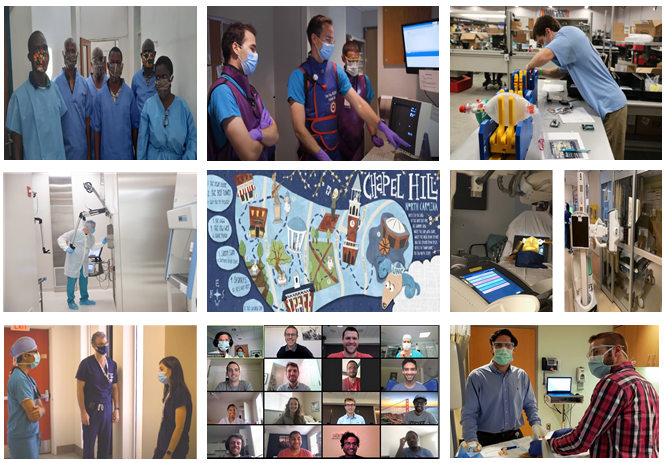We have had a challenging six+ months since our last IMAGES newsletter. The world is dealing with the COVID-19 pandemic and we are not immune. UNC Department of Radiology has responded to this unanticipated challenge, and we would like to thank all the people who have made our response possible.
Our early pandemic preparedness was focused on improving remote PACS access to allow for greater physical separation between our people and to enhance resiliency in case of expected COVID-19 exposures or illness. A collaborative task force comprised of UNC School of Medicine and UNC Health radiologic care leadership formed to guide PACS workstation deployment to faculty homes and “borrowed” hospital spaces. These efforts paid off. We increased coverage for subspecialty services, created scheduling flexibility for quarantine planning and increased our capacity to finalize reports for emergent cases. Onsite, PACs stations set up outside our traditional UNC Hospitals reading rooms allowed for greater distancing. I am happy to report that we have had very few illnesses or absences related to COVID-19 amongst our radiology personnel.
On the patient care side, we reconfigured appointment schedules and workflows to promote distancing in time and space between patients, while trying to preserve high availability of our services. Mid-March, non-emergent imaging appointments were suspended. To sustain essential breast cancer and procedural care, the Breast Imaging division worked with surgical oncology to ensure scheduling of cases that couldn’t be postponed. In our other imaging divisions, residents assisted attendings with review of all scheduled imaging studies to determine essential and high-priority procedures and to reschedule non-urgent appointments.
To sustain our teaching mission, the Diagnostic and Interventional Radiology residencies leadership compensated for the loss of direct reading room and procedural case volume with enhanced virtual didactics and case conferences. Admirably, senior residents volunteered to assist faculty in leading these educational initiatives. When the School of Medicine suspended medical student clinical rotations at the pandemic’s outbreak, redesigned virtual medical student education supplemented distance learning. Didactic and interactive teaching in virtual forums, including journal clubs, conferences and symposia were rolled out rapidly. Several months after the COVID-19 outbreak, we were pleased to welcome screened medical students back to reading rooms in a hybrid model (RADY 403 – Pediatric Imaging) alternating remote learning with reading room experiences.
Our Clinical and Basic Research areas sustained their work in the face of UNC safety constraints placed mid-March on non-critical research being conducted on campus.
Biomedical Research Imaging Center (BRIC) labs conducting research that would be difficult to suspend and to restart have continued their critical work on campus. Both the Small Animal Imaging (SAI) Facility and the Cyclotron and Radiochemistry Facility have reduced personnel in their laboratory spaces, adhered strictly to pandemic precautions, and conducted frequent wellness checks. Careful use of gloves, masks, face shields and other PPE critical to the medical supply chain strained by COVID-19 has avoided shortages. UNC Imaging Analysis Group Director Pew-Thian Yap, PhD, described his team’s adjustment to working in the COVID-19 era with a phrase that speaks for us all – “We are adapting to the ‘new normal.’”
The mid-March suspension by the University of all non-essential research activity placed our Clinical Research team’s in-person study visits on hold. They shifted to phone and video follow-up visits and continued retrospective studies remotely. Working from home, the team conducted new study start-up, core image de-identification and transmittal, database development and other tasks critical to sustaining clinical trials. When the division resumed onsite staffing in June, it established a rotating work schedule with 50% staffing density on campus each day. Alternate days, the research coordinators worked remotely. In-person study visits have resumed, with strict adherence to extensive COVID-19 safeguards to ensure provider/patient safety.
Our Department’s personnel have adapted to restructured routines, protocols and infrastructure to sustain our patient care, education, research and administrative support at UNC. We have incorporated innovation, alternate approaches and A LOT of patience into our daily work. Working together, we should all be proud of our ability to maintain and advance our missions of excellence in patient care, education and research in this trying time.

